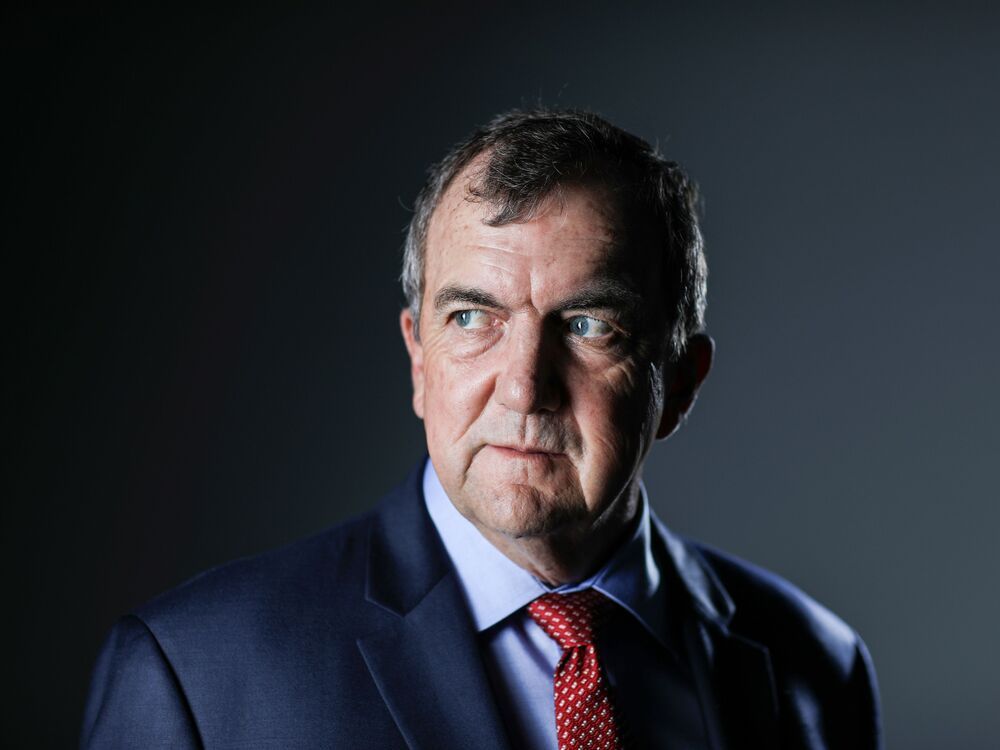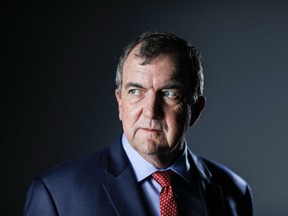Barrick CEO suggests miners overpaying for assets amid higher gold prices

Barrick is committed to not paying premiums, Mark Bristow says

Article content
Shares in Toronto-based Barrick Gold Corp. spiked eight per cent on Wednesday as the company reported higher fourth quarter earnings and announced a new US$1-billion buyback program.
Advertisement
Story continues below
This advertisement has not loaded yet, but your article continues below.
Article content
Chief executive Mark Bristow said the company is implementing the share buyback program because the market is not adequately valuing Barrick.
Although gold prices are up 15 per cent, and inflation, normally a trigger for higher gold prices, is reaching the highest point in decades around the world, many gold mining executives say they are not benefiting.
Barrick’s stock, even after rising Wednesday, traded at $27.58 per share, roughly even with its price in February 2020. Bristow noted Colorado-based Newmont Corp. — the largest gold miner in the world, while Barrick is second — has diverged and its shares have risen 25 per cent since February 2020. It announced a US$1-billion share buyback in January 2021.
“We’ve seen a big divergence, from some, well one of our peers,” said Bristow, adding, “Our discussion with our board and our shareholders, is … we shouldn’t be watching our share price languish relative to anything else, and there are moments when it makes good sense to implement some buybacks.”
Advertisement
Story continues below
This advertisement has not loaded yet, but your article continues below.
Article content
Barrick also sat on the sidelines as a string of mergers swept up many of the gold mines and attractive exploration assets in Canada, where Bristow has said his company would like to expand since it only has one mine in the country.
This includes Agnico Eagle Mines Ltd.’s $13.4-billion acquisition of Kirkland Lake Gold Ltd. last September, Australia’s Newcrest Mining Ltd.’s $3.5-billion purchase of Pretium Resources Inc. in January, and Kinross Gold Corp.’s $1.8-billion acquisition of Great Bear Resources Ltd. in December 2021.
One thing you can be sure if you’ve been around as long as me is that US$1,800 (per ounce) gold masks a lot
Mark Bristow
Bristow, however, said Barrick is committed to not paying premiums for assets, and suggested other gold mining companies were overpaying.
“Some of these assets that were dealt last quarter, they’ve been around a long time and we all walked away from them at lower gold prices,” said Bristow. “One thing you can be sure if you’ve been around as long as me is that US$1,800 (per ounce) gold masks a lot.”
Advertisement
Story continues below
This advertisement has not loaded yet, but your article continues below.
Article content
Barrick would only pay a premium under circumstances in which it felt it could unlock value from an asset, he said.
He noted that during the last period of elevated gold prices, around 2012 and 2013 — just before gold dropped to a range between US$1,100 and US$1,300 for several years — he was chief executive of Randgold Resources, and shareholders were clamouring for the company to grow through acquisitions.
But Bristow said he resisted such pressures, and although Randgold’s shares lagged other companies for a period, they surged relative to the rest of the sector after gold prices dropped.
“I’ve never gambled in the way I run my business,” he said.
In an interview with the Financial Post, Bristow described the share buyback as a “red herring.” He said the mergers from the past year look more to him like the industry falling into bad habits and overpaying for assets that might not perform if the gold price sinks.
Advertisement
Story continues below
This advertisement has not loaded yet, but your article continues below.
Article content
Bristow was critical of Kinross Gold’s acquisition of Great Bear Resources, saying the $1.8-billion sale price ascribes a value that would befit a mine with eight million ounces of gold in reserves. But Great Bear has not proven it has any reserves, let alone obtained the permits or agreements with First Nations that would allow it to build a mine.
I’ve never gambled in the way I run my business
Mark Bristow
Great Bear has drilled holes and hit high concentrations of gold, but it remains many steps away from calculating the likely amount of gold.
“It’s a piece of ground, a prospective piece of exploration ground with some bore holes in it,” he said. “And the market put an 8-million ounce resource on it. That would make it one of the biggest gold mines ever in Canada. But it’ll take you eight years to actually start building it.”
Advertisement
Story continues below
This advertisement has not loaded yet, but your article continues below.
Article content
Bristow said a complex set of forces are at work that leave the economic outlook more uncertain than ever: the growth of fiat currencies as a result of government recovery packages implemented during the pandemic, the way climate change is being addressed and growing inequality.
“People have just printed that money,” he said. “The developed world was always the example of government fiscal discipline, and now we’ve got more debt than all the emerging world put together and it’s all going to end in tears.”
He brought up the concept of a “grey rhino” event — an event clearly visible on the horizon, but which people ignore at their own peril. The concept is laid out in the book, The Gray Rhino: How to Recognize and Act on the Obvious Dangers We Ignore, by Michelle Wucker, which Bristow said he urges his executive team to read.
Advertisement
Story continues below
This advertisement has not loaded yet, but your article continues below.
Article content
“It’s always much easier to ignore it and believe the promoters and think it’s all going to be fine,” he said.
But he argued forces are building, from inflation to inequality to deglobalization, that will cause gold prices to rise again.
Looking at 2022 broadly, the company delivered on guidance for a third consecutive year and held US$130 million in cash. In the fourth quarter, net earnings doubled to US$726 million from US$347 million in the third quarter.
-

How gold miners lost their mojo
-

‘Almost like Star Trek’: New startup helps miners stare deep into the earth with cosmic rays
-

Gold miners Agnico Eagle, Kirkland Lake propose $13.5 billion mega-merger
-

Barrick Gold lost its ‘social licence’ in Papua New Guinea. This is the price it’s paying to earn it back
Advertisement
Story continues below
This advertisement has not loaded yet, but your article continues below.
Article content
The company also said it had replaced its reserves, improving quantity and quality, with proven and probable reserves rising from 68 million ounces at 1.66 grams per tonne in 2020, to 69 million ounces at 1.71 grams per tonne today. The company continues to include in its reserve calculations only ore that is economic to mine at US$1,200 per ounce of gold — well below the current price of US$1,862 per ounce.
Barrick increased its dividend by 11 per cent to 10 cents in the fourth quarter and distributed a record $1.4 billion to shareholders throughout the year. It also set a new dividend policy that adds a performance dividend linked to its cash balance, on top of a base dividend.
While inflation could help gold prices, it also affects profits. Barrick’s expected cash costs in 2022 have risen to the high point of its past estimates of three to five per cent, and it is now guiding at 4.8 per cent. Meanwhile, its expected capex expenditures this year have risen to US$2.05 billion, up 13 per cent from previous estimates.
Bristow stressed said that Barrick is focused on the longterm and creating a large company “that’s relevant in the public markets,” meaning large enough to draw interest from institutional investors. It would grow organically, through exploration and by hiring “high quality” people to run its mines, he said.
• Email: [email protected] | Twitter: GabeFriedz
Advertisement
Story continues below
This advertisement has not loaded yet, but your article continues below.









